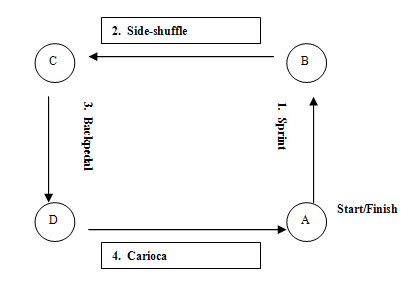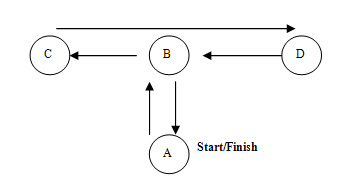If the thought of pedaling a stationary bike or walking on a treadmill instigates a yawn or a genuine lack of enthusiasm, you are not alone. If you want to change up your routine and create a great cardio challenge for yourself, try performing an agility training routine. Agility training is another form of cardio fitness that can be fun and create more helpful results for the body than simply increasing cardiovascular efficiency and decreasing body fat. If you are looking to give your cardio fitness a kick, add fun to your routine and increase your body’s ability to function and avoid injury, agility training is definitely worth investigating.
Agility training teaches the body to start, stop, and change direction quickly while maintaining proper posture. Agility challenges you to control your center of gravity over a changing base of support while changing directions at varying speeds. It is important to remember that we move at varying speeds and in various planes each day. Training to improve movement not only increases functional capabilities, but will help you avoid injuries by teaching your mind and body to work together and move at different speeds using the correct muscle at the correct time in the correct plane of motion. Agility training can provide you with numerous overall training benefits such as challenging your core, legs, balance, reactive capabilities, and increasing your cardiovascular efficiency.
Agility work can be done using cones or lines and is best performed on a basketball court, tennis court, or in an aerobics room. Performing agility drills on concrete is not advised and may be harmful to your body. Opt for surfaces that provide better control for short, quick movements and avoid surfaces that may have loose gravel or feel slippery. With agility training, the proper surface can make all the difference.
Below are a few different drills you can utilize within an agility training program:
1. 5-10-5 Drill: Begin with three cones, placing two cones 10 meters apart. Place the final cone at the midpoint. Start at the middle cone A and sprint to cone B, then to cone C, and back to cone A. For increased intensity, get a friend to time you as you complete the drill.

2. Box Drill: Place four cones in a square pattern, approximately 10 yards away from each other. Start at cone A and sprint to cone B. Side shuffle from cone B to cone C. Backpedal from cone C to cone D and carioca from cone D to cone A. Try to maintain appropriate speeds and form.

3. T-Drill: Place four cones 5 yards apart from each other in a “T” pattern as shown below. Sprint from cone A to Cone B. Side shuffle from cone B to cone C. Carioca from cone C to cone D and side shuffle from cone D to cone B. Backpedal from cone B to cone A.

Watch your key checkpoints to make sure you are performing your drills correctly. Always be aware of your body position during your drills. Good agility comes from good form!
Be sure to design your agility workout so that you have time for a proper warm-up and cool-down. Both are essential to good form and injury prevention. As with any program, try not to overdo it! Work an agility program into your routine performing this workout one to two days a week. You must give your body time to adapt to the new program in the beginning and give your body time to recover after performing this workout.
If the thought of pedaling a stationary bike or walking on a treadmill instigates a yawn or a genuine lack of enthusiasm, you are not alone. If you want to change up your routine and create a great cardio challenge for yourself, try performing an agility training routine. Agility training is another form of cardio fitness that can be fun and create more helpful results for the body than simply increasing cardiovascular efficiency and decreasing body fat. If you are looking to give your cardio fitness a kick, add fun to your routine and increase your body’s ability to function and avoid injury, agility training is definitely worth investigating.
Agility training teaches the body to start, stop, and change direction quickly while maintaining proper posture. Agility challenges you to control your center of gravity over a changing base of support while changing directions at varying speeds. It is important to remember that we move at varying speeds and in various planes each day. Training to improve movement not only increases functional capabilities, but will help you avoid injuries by teaching your mind and body to work together and move at different speeds using the correct muscle at the correct time in the correct plane of motion. Agility training can provide you with numerous overall training benefits such as challenging your core, legs, balance, reactive capabilities, and increasing your cardiovascular efficiency.
Agility work can be done using cones or lines and is best performed on a basketball court, tennis court, or in an aerobics room. Performing agility drills on concrete is not advised and may be harmful to your body. Opt for surfaces that provide better control for short, quick movements and avoid surfaces that may have loose gravel or feel slippery. With agility training, the proper surface can make all the difference.
Below are a few different drills you can utilize within an agility training program:
1. 5-10-5 Drill: Begin with three cones, placing two cones 10 meters apart. Place the final cone at the midpoint. Start at the middle cone A and sprint to cone B, then to cone C, and back to cone A. For increased intensity, get a friend to time you as you complete the drill.

2. Box Drill: Place four cones in a square pattern, approximately 10 yards away from each other. Start at cone A and sprint to cone B. Side shuffle from cone B to cone C. Backpedal from cone C to cone D and carioca from cone D to cone A. Try to maintain appropriate speeds and form.

3. T-Drill: Place four cones 5 yards apart from each other in a “T” pattern as shown below. Sprint from cone A to Cone B. Side shuffle from cone B to cone C. Carioca from cone C to cone D and side shuffle from cone D to cone B. Backpedal from cone B to cone A.

Watch your key checkpoints to make sure you are performing your drills correctly. Always be aware of your body position during your drills. Good agility comes from good form!
Be sure to design your agility workout so that you have time for a proper warm-up and cool-down. Both are essential to good form and injury prevention. As with any program, try not to overdo it! Work an agility program into your routine performing this workout one to two days a week. You must give your body time to adapt to the new program in the beginning and give your body time to recover after performing this workout.

No comments:
Post a Comment